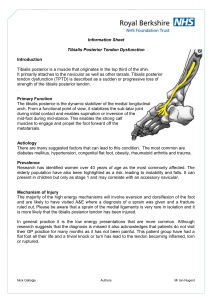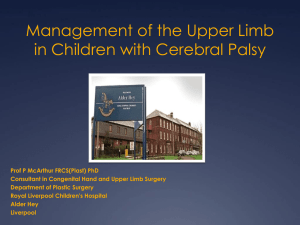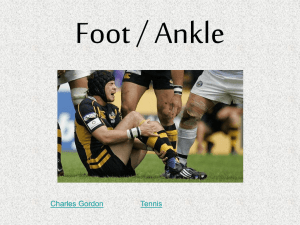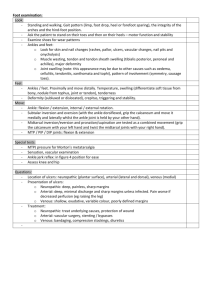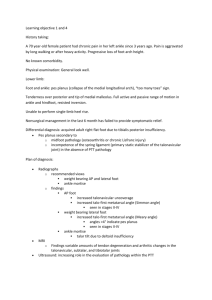Calcaneal osteotomy and transfer of the dysfunction of tibialis posterior
advertisement
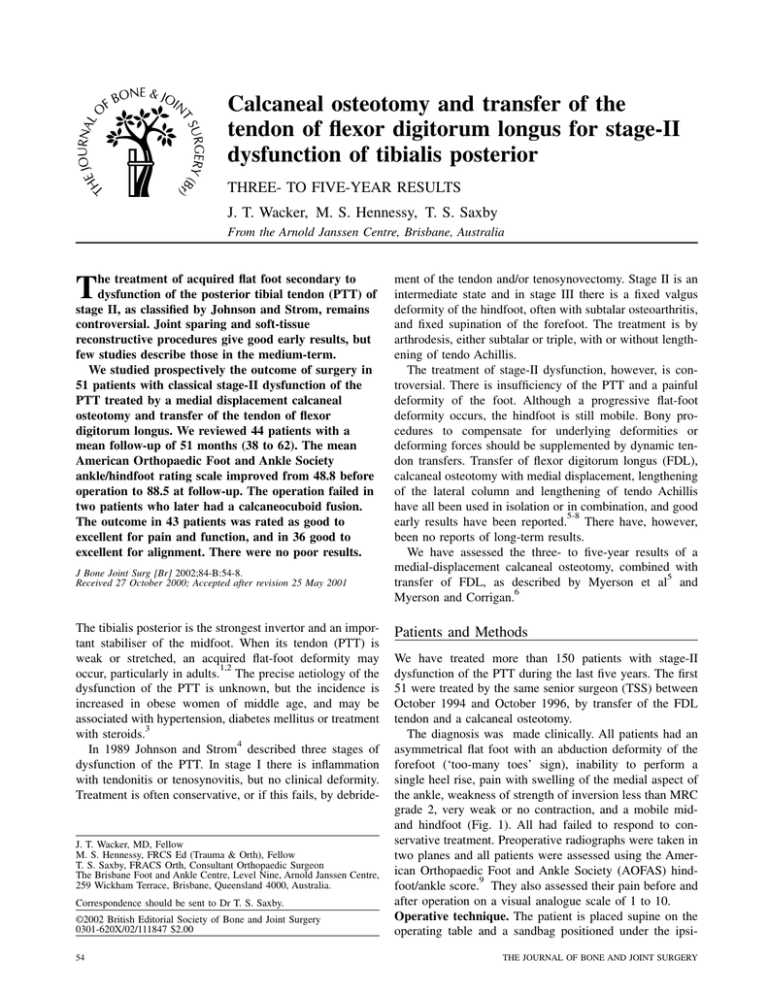
Calcaneal osteotomy and transfer of the tendon of flexor digitorum longus for stage-II dysfunction of tibialis posterior THREE- TO FIVE-YEAR RESULTS J. T. Wacker, M. S. Hennessy, T. S. Saxby From the Arnold Janssen Centre, Brisbane, Australia he treatment of acquired flat foot secondary to dysfunction of the posterior tibial tendon (PTT) of stage II, as classified by Johnson and Strom, remains controversial. Joint sparing and soft-tissue reconstructive procedures give good early results, but few studies describe those in the medium-term. We studied prospectively the outcome of surgery in 51 patients with classical stage-II dysfunction of the PTT treated by a medial displacement calcaneal osteotomy and transfer of the tendon of flexor digitorum longus. We reviewed 44 patients with a mean follow-up of 51 months (38 to 62). The mean American Orthopaedic Foot and Ankle Society ankle/hindfoot rating scale improved from 48.8 before operation to 88.5 at follow-up. The operation failed in two patients who later had a calcaneocuboid fusion. The outcome in 43 patients was rated as good to excellent for pain and function, and in 36 good to excellent for alignment. There were no poor results. T J Bone Joint Surg [Br] 2002;84-B:54-8. Received 27 October 2000; Accepted after revision 25 May 2001 The tibialis posterior is the strongest invertor and an important stabiliser of the midfoot. When its tendon (PTT) is weak or stretched, an acquired flat-foot deformity may 1,2 occur, particularly in adults. The precise aetiology of the dysfunction of the PTT is unknown, but the incidence is increased in obese women of middle age, and may be associated with hypertension, diabetes mellitus or treatment 3 with steroids. 4 In 1989 Johnson and Strom described three stages of dysfunction of the PTT. In stage I there is inflammation with tendonitis or tenosynovitis, but no clinical deformity. Treatment is often conservative, or if this fails, by debride- J. T. Wacker, MD, Fellow M. S. Hennessy, FRCS Ed (Trauma & Orth), Fellow T. S. Saxby, FRACS Orth, Consultant Orthopaedic Surgeon The Brisbane Foot and Ankle Centre, Level Nine, Arnold Janssen Centre, 259 Wickham Terrace, Brisbane, Queensland 4000, Australia. Correspondence should be sent to Dr T. S. Saxby. ©2002 British Editorial Society of Bone and Joint Surgery 0301-620X/02/111847 $2.00 54 ment of the tendon and/or tenosynovectomy. Stage II is an intermediate state and in stage III there is a fixed valgus deformity of the hindfoot, often with subtalar osteoarthritis, and fixed supination of the forefoot. The treatment is by arthrodesis, either subtalar or triple, with or without lengthening of tendo Achillis. The treatment of stage-II dysfunction, however, is controversial. There is insufficiency of the PTT and a painful deformity of the foot. Although a progressive flat-foot deformity occurs, the hindfoot is still mobile. Bony procedures to compensate for underlying deformities or deforming forces should be supplemented by dynamic tendon transfers. Transfer of flexor digitorum longus (FDL), calcaneal osteotomy with medial displacement, lengthening of the lateral column and lengthening of tendo Achillis have all been used in isolation or in combination, and good 5-8 early results have been reported. There have, however, been no reports of long-term results. We have assessed the three- to five-year results of a medial-displacement calcaneal osteotomy, combined with 5 transfer of FDL, as described by Myerson et al and 6 Myerson and Corrigan. Patients and Methods We have treated more than 150 patients with stage-II dysfunction of the PTT during the last five years. The first 51 were treated by the same senior surgeon (TSS) between October 1994 and October 1996, by transfer of the FDL tendon and a calcaneal osteotomy. The diagnosis was made clinically. All patients had an asymmetrical flat foot with an abduction deformity of the forefoot (‘too-many toes’ sign), inability to perform a single heel rise, pain with swelling of the medial aspect of the ankle, weakness of strength of inversion less than MRC grade 2, very weak or no contraction, and a mobile midand hindfoot (Fig. 1). All had failed to respond to conservative treatment. Preoperative radiographs were taken in two planes and all patients were assessed using the American Orthopaedic Foot and Ankle Society (AOFAS) hind9 foot/ankle score. They also assessed their pain before and after operation on a visual analogue scale of 1 to 10. Operative technique. The patient is placed supine on the operating table and a sandbag positioned under the ipsiTHE JOURNAL OF BONE AND JOINT SURGERY CALCANEAL OSTEOTOMY AND TRANSFER OF THE TENDON OF FLEXOR DIGITORUM LONGUS Fig. 1 Clinical appearance of a patient with dysfunction of the tendon of tibialis posterior on the left and demonstrating the ‘too-many toes’ sign, increased hindfoot valgus, and medial swelling. lateral buttock to rotate the limb internally, allowing access to the lateral aspect of the calcaneus for the osteotomy, which is performed first. An oblique incision is made behind and approximately 2 cm distal to the lateral malleolus, avoiding the sural nerve. A calcaneal osteotomy is performed at an angle of approximately 45° to the sole of the foot and the distal segment is displaced medially for 1 cm and held by a cannulated, partially-threaded, 6.5 mm cancellous screw (Fig. 2). The lateral wound is closed and the sandbag removed. A medial incision is then made along the line of the PTT and extended distally to expose the tendon of FDL. The PTT, spring ligament and FDL are identified. Approximately 5 cm of the PTT are excised, which is the diseased portion. The tendon of FDL is followed to the knot of Henry and divided distally. A 4.5 mm drill hole is made from the dorsal to plantar direction in the navicular, and the tendon of FDL is rerouted through the navicular from plantar to dorsal, holding the forefoot inverted and sutured back on itself. The wound is closed and a plaster backslab applied in a position of moderate equinus and varus for 12 to 14 days. Inspection of the wound is carried out at this time with removal of the sutures and a full, lightweight below-knee fibreglass cast applied in a neutral position for a further four weeks. The patient remains non-weight-bearing for six weeks, the cast is then removed and radiographs taken to assess the healing of the osteotomy. After removal of the cast the patient gradually increases weight-bearing as pain allows and physiotherapy is undertaken until a single-heel rise can be performed comfortably. Orthoses are not routinely prescribed after operation but may be used at the discretion of the patient. All patients attended for routine follow-up during the first 12 months and for longer if necessary; they were further assessed at a minimum of three years using the AOFAS hindfoot score. Results There were 30 women and 18 men with a mean age of 61.3 years (38 to 80). In 26 the right foot was affected, in 22 the Fig. 2b An axial radiograph of the heel showing the medial displacement osteotomy held by a cannulated screw (a) and a lateral radiograph of the hindfoot showing the osteotomy and internal fixation (b). Fig. 2a VOL. 84-B, NO. 1, JANUARY 2002 55 56 J. T. WACKER, M. S. HENNESSY, T. S. SAXBY Fig. 3a Fig. 3b Photographs showing the clinical appearance of the patient in Figure 1 after operation with a) correction of the hindfoot valgus and normal alignment of the hindfoot and b) from the medial aspect with the operation scar and restoration of the medial longitudinal arch. left. Of the three patients who were not available for follow-up, two had moved and one had died from an unrelated condition. Four others were unable to attend for clinical review but were contacted by telephone and asked the same questions regarding function, pain and outcome. All of these were satisfied with the result. This left 44 patients who attended for clinical review. The patients had had symptoms for a mean of 27.6 months (4 to 120) before presentation and in only 16 (33%) had the correct diagnosis been made before then. Of the 44, 22 (46%) claimed to have had pre-existing bilateral flat feet, 12 (24%) a non-specific injury to their feet with no clear correlation with dysfunction of the PTT and two (4%) a clearer relation between injury and onset. In 38 (79%), there were other factors which were likely to predispose to dysfunction of the PTT, such as obesity (36, 75%), hyper3 tension (8, 17%) and rheumatoid disease (2, 4%). At a mean of 51 months (38 to 62) after surgery, of the 48 patients reviewed, 25 (52%) were very satisfied with the operation, 19 (40%) were satisfied with minor reservations, two (4%) were satisfied with reservations, and two (4%) were dissatisfied. The latter two subsequently underwent calcaneocuboid fusion. All except three would have elected to undergo the procedure again. The AOFAS rating scale improved from a mean of 48.8 before operation to a mean of 88.5 at review. Most notable was the improvement in the pain score from a mean of 12.3 to 34.4, with all patients describing less pain. This was confirmed by the visual analogue scores, with mean improvement from 7.3 to 1.7. Six patients complained of occasional mild medial pain after activity and 12 had occasional mild lateral pain. None required analgesia. The functional scores improved from a mean of 35.8 before to a mean of 46.6 after operation. All patients had considerable limitation of daily activities before operation. At review, only two complained of any such restriction. All patients were able to do a single-heel rise. Three had difficulties with repeated heel rises. The strength of inversion was MRC grade 4 to grade 5 in all patients. An improvement in alignment was noted by 92% of the patients (Fig. 3) although in 12 (25%) the objective alignment was only fair and 16 patients were using orthoses in the form of insoles for support of the medial arch. Nine patients complained of similar problems in the other foot. One had transfer of the tendon of FDL one year after the first operation and one is awaiting this operation. Complications. The operation failed in two patients who later underwent calcaneocuboid fusion. There was a good outcome in one, while the other still complains of pain in the forefoot. All the osteotomies healed clinically and radiologically although five patients had pain in the region of the screw in the calcaneus; this was removed between eight and 24 months after operation. There were three superficial wound infections which were treated successfully with oral antibiotics. Six patients complained of reduced sensation around the scars, in three cases medial and in three lateral. In five this was not a problem, but one patient had a sural neuritis which required neurolysis although no neuroma was seen. He developed a wound infection and still has discomfort around the wound. Two patients had a symptomatic deep-vein thrombosis and one a pulmonary embolus, but all recovered satisfactorily. Forty-four (92%) of the patients were either totally satisfied with the outcome or were satisfied with minor reservations. Of the others, the treatment failed in two and two were satisfied with major reservations. Of these, one complained of pain in the lateral aspect of the ankle with instability, and the other was satisfied until 18 months after the operation when he noticed recurrence of the collapsed arch and discomfort when wearing shoes without orthotics. Three patients were aware of recurrence of the collapsed arch, but without further pain or loss of function. THE JOURNAL OF BONE AND JOINT SURGERY CALCANEAL OSTEOTOMY AND TRANSFER OF THE TENDON OF FLEXOR DIGITORUM LONGUS Most patients were very satisfied, with relief from pain soon after the operation. It took, however, a mean of 7.8 months (3 to 18) to recover fully from the operation. Discussion Soft-tissue surgery alone such as direct repair of the PTT and tenodesis to the tendon of FDL, can give good functional results and excellent relief from pain at a mean 10 follow-up of 27 months. Other studies have also shown 1,11 good relief from pain with soft-tissue procedures only. Despite having a cross-sectional area of one-third that of the PTT, the transfer of the FDL tendon takes over the function of the PTT with restoration of the strength of 1 inversion and a satisfactory single-heel rise. This was confirmed by the patients in this study in whom even with excision of part of the PTT the ability to do repetitive single-heel rises was restored, as was the strength of inversion. Less predictable is the ability of such operations to restore a weight-bearing arch, which was seen in only 41% 10 in Shereff’s series, and to correct the forefoot abduction. This is the reason for the interest in additional bony procedures to compensate for and correct these deformities or the forces giving rise to them. Most surgeons use either a medial displacement osteotomy or a procedure for lengthening the lateral column, either in the form of a distraction arthrodesis of the calcaneocuboid joint or a distraction osteotomy through the anterior process of the 7,12-14 calcaneus. In our study, neither tenodesis of the FDL to the PTT nor plication of the spring ligament was performed. 11 Cracchiolo emphasises the role of the static supports, the spring ligament complex and joint capsules, in the maintenance of the normal arch, and recommends routine exploration and plication or augmentation of the spring ligament if it is damaged. He reported excellent results in 14 of a series of 18 patients at a mean follow-up of 31 months, with no associated bony procedure. Since there was only fair alignment in 25% of our patients and collapse of the arch in three, this latter modification has now been adopted by the senior author (TSS) in all cases, as well as a tenodesis of the FDL to the proximal PTT if it remains mobile. Whether this will improve the outcome remains to be seen. A tenodesis of the distal FDL to flexor hallucis longus was not performed because the tendons are conjoined distal to the knot of Henry. None of our patients complained of weakness of flexion of the lesser toes. There is still no exact biomechanical explanation of the calcaneus osteotomy. The medial displacement redirects the pull of tendo Achillis, changing the valgus force on the hindfoot to varus. This cannot be explained by a tightening of the plantar fascia and the windlass mechanism since the reverse actually happens. It is more likely that the osteotomy restores the alignment of the talonavicular joint. Otis 15 et al and others have recently shown that the medial VOL. 84-B, NO. 1, JANUARY 2002 57 displacement calcaneal osteotomy allows elongation of the spring ligament on weight-bearing, but with a shorter length of ligament, and affords protection to the ligament from levels of force experienced when intact and when the lateral column has been lengthened. Lengthening of the lateral column is preferred by some 7,8 7 authors. Pomeroy and Manoli tried to address all components of a stage-II dysfunction of the PTT with lengthening of tendo Achillis, transfer of the tendon of FDL to the medial cuneiform, lengthening of the lateral column and medial-displacement calcaneal osteotomy. At a mean follow-up of 17.5 months the results showed an increase in the AOFAS score from 51.4 to 82.8 and a statistically significant maintenance of the correction of the planovalgus deformity radiologically. We believe that this more extensive operation is not always necessary, but that in some patients with gross preoperative malalignment, improvement could be achieved by an additional procedure, such as lengthening of the lateral column in addition to the calcaneal osteotomy and FDL tendon transfer. However, if the alignment is fair and the patient is free from pain, even with the use of insoles the extra morbidity of lengthening of the lateral column may not be required. We did not study the radiological changes in our patients because the preoperative radiographs were not always available at follow-up and there was no standardisation. There is rarely a clear correlation between the radiological 1 evaluation, the clinical findings and patient satisfaction. MRI, however, may help to direct the surgical decision. 16 Conti, Michelson and Jahss found in a retrospective study that preoperative MRI was the best predictor of the surgical outcome, especially with reconstruction of the PTT, giving better delineation of the pathology than intraoperative inspection, with MRI detecting intratendinous tears and degeneration that was not obvious at surgery. If the PTT is excised, however, this becomes irrelevant. Our patients did not have MRI as a routine procedure. If these results are maintained in the longer term we feel that medial displacement calcaneal osteotomy and FDL tendon transfer is an excellent procedure for the treatment of the stage-II PTT-deficient foot. It is not too technically demanding, is reproducible, has a low rate of complications and gives good patient satisfaction after a predictable time. There is a wide spectrum of deformity and disability encompassed in the stage-II subgroup. Subclassification would appear to be the most logical step forward but also the most difficult. There may be some merit in performing a radiological study of the talonavicular coverage angle. No benefits in any form have been received or will be received from a commercial party related directly or indirectly to the subject of this article. References 1. Mann RA, Thompson FM. Rupture of the posterior tibial tendon causing flat foot. J Bone Joint Surg [Am] 1985;67-A:556-61. 58 J. T. WACKER, M. S. HENNESSY, T. S. SAXBY 2. Funk DA, Cass JR, Johnson KA. Acquired adult flat foot secondary to posterior tibial tendon pathology. J Bone Joint Surg [Am] 1986;68-A:95-102. 3. Holmes GB Jr, Mann RA. Possible epidemiological factors associated with rupture of the posterior tibial tendon. Foot Ankle 1992;13:70-9. 4. Johnson KA, Strom DE. Tibialis posterior tendon dysfunction. Clin Orthop 1989;239:196-206. 5. Myerson MS, Corrigan J, Thompson F, Schon LC. Tendon transfer combined with calcaneal osteotomy for treatment of posterior tibial tendon insufficiency: a radiological investigation. Foot Ankle Int 1995;16:712-8. 6. Myerson MS, Corrigan J. Treatment of posterior tibial tendon dysfunction with flexor digitorum longus tendon transfer and calcaneal osteotomy. Orthopedics 1996;19:383-8. 7. Pomeroy CG, Manoli A 2nd. A new operative approach for flat foot secondary to posterior tibial tendon insufficiency: a preliminary report. Foot Ankle Int 1997;18:206-12. 8. Hintermann B, Valderrabano V, Kundert HP. Anteriore Kakaneusverlangerungsosteotomie und mediale Weichteilrekonstruktion zur Behandlung der schweren Tibialis posterior-Sehnendysfunktion. Orthopade 1999;28:760-9. 9. Kitaoka HB, Alexander IJ, Adelaar RS, et al. Clinical rating systems for the ankle-hindfoot, midfoot, hallux, and lesser toes. Foot Ankle 1994;15:349-53. 10. Shereff MJ. Treatment of ruptured posterior tibial tendon with direct repair and FDL tenodesis. Foot Ankle Clin 1997;2:281-96. 11. Cracchiolo A III. Evaluation of spring ligament pathology in patients with posterior tibial tendon rupture, tendon transfer and ligament repair. Foot Ankle Clin 1997;2:297-307. 12. Myerson MS. Adult acquired flatfoot deformity. J Bone Joint Surg [Am] 1996;78-A:780-92. 13. Saxby TS, Myerson MS. Calcaneus osteotomy. In: Myerson MS, ed. Current therapy in foot and ankle surgery. St Louis: Mosby-Year Book, 1993:159-62. 14. Trnka H-J, Easley ME, Myerson MS. The role of calcaneal osteotomies for the correction of adult flatfoot. Clin Orthop 1999;365:50-64. 15. Otis JC, Deland JT, Kenneally S, Chang V. Medial arch strain after medial displacement calcaneal osteotomy: an in vitro study. Foot Ankle Int 1999;20:222-6. 16. Conti S, Michelson J, Jahss M. Clinical significance of magnetic resonance imaging in preoperative planning for reconstruction of posterior tibial tendon ruptures. Foot Ankle 1992;13:208-14. THE JOURNAL OF BONE AND JOINT SURGERY



